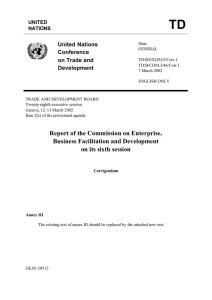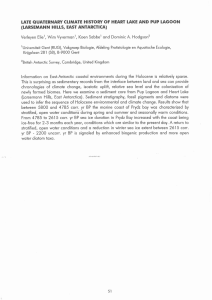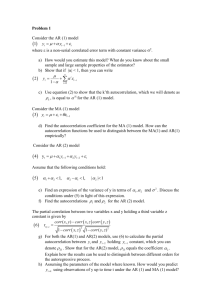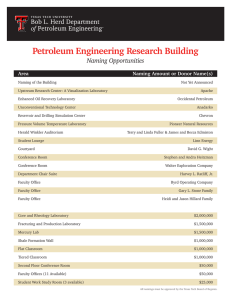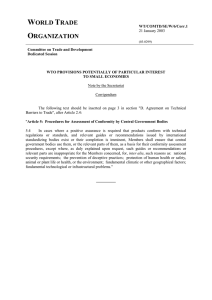Why Aren’t Developed Countries Saving? Loretti I. Dobrescu, Laurence J. Kotliko¤
advertisement
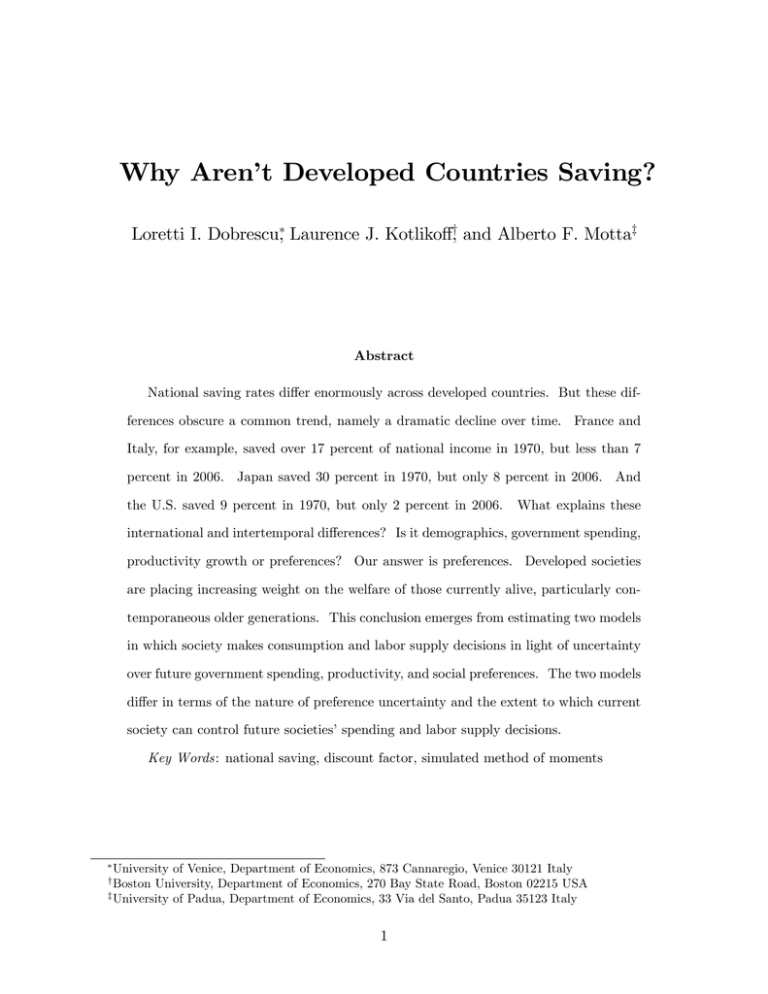
Why Aren’t Developed Countries Saving? Loretti I. Dobrescu, Laurence J. Kotliko¤y, and Alberto F. Mottaz Abstract National saving rates di¤er enormously across developed countries. But these differences obscure a common trend, namely a dramatic decline over time. France and Italy, for example, saved over 17 percent of national income in 1970, but less than 7 percent in 2006. Japan saved 30 percent in 1970, but only 8 percent in 2006. And the U.S. saved 9 percent in 1970, but only 2 percent in 2006. What explains these international and intertemporal di¤erences? Is it demographics, government spending, productivity growth or preferences? Our answer is preferences. Developed societies are placing increasing weight on the welfare of those currently alive, particularly contemporaneous older generations. This conclusion emerges from estimating two models in which society makes consumption and labor supply decisions in light of uncertainty over future government spending, productivity, and social preferences. The two models di¤er in terms of the nature of preference uncertainty and the extent to which current society can control future societies’spending and labor supply decisions. Key Words: national saving, discount factor, simulated method of moments University of Venice, Department of Economics, 873 Cannaregio, Venice 30121 Italy Boston University, Department of Economics, 270 Bay State Road, Boston 02215 USA z University of Padua, Department of Economics, 33 Via del Santo, Padua 35123 Italy y 1 1 Introduction National saving rates di¤er enormously across developed countries. mask a common trend, namely a dramatic decline over time. But these di¤erences Table 1 documents this phenomenon. It shows national saving rates for the U.S., Japan, U.K., France, Italy, Spain, and Canada for selected years from 1970 through 2006. With the exception of Canada, each country’s saving rate plummeted over this period. France, for example, saved 17.3 percent of national income in 1970. In 2006 it saved only 6.6 percent. Italy saved 17.4 percent of its income in 1970, but only 4.2 percent rate in 2006. And the U.S. saved at 9.5 percent of its income in 1970, but almost nothing in 2006. What explains these di¤erences across countries and over time? Is it changes in de- mographics, preferences, government spending or economic conditions? To address this question, we estimate a model in which the government and household sector jointly make labor supply and consumption decisions. This societal decision-making framework is motivated by Green and Kotliko¤’s (2006) demonstration that economic models with rational agents draw no distinction between private and public property. Instead, the government and household sectors e¤ectively play the role of two people stranded on an island, each of whom can claim, via "o¢ cial," "legal," or informal proclamation, to own all or part of the island’s resources, including his own and the other party’s time. But such claims have no economic basis or import. What each person ends up consuming in goods and leisure depends on fundamental factors, including the ability to threaten and cajole. Our one-good, closed-economy model assumes that the government and the public (society) resolve their con‡icts and capitalize on their opportunities by agreeing to maximize a social welfare function. This function equals the expected discounted ‡ow of utility from the public’s future consumption and leisure. Each period’s consumption and leisure decisions are made in light of uncertain future levels of productivity and government spending as well as uncertain future social preferences. We model social preference-uncertainty in two ways. In model 1, current society is in 2 charge forever. It knows its current intertemporal preferences (rate of time preference) and current intratemporal preferences (relative weighting of di¤erent age groups’utilities from consumption and leisure). What it doesn’t know is its future intertemporal preferences (how its rate of time preference will evolve). Model 2 is a time-inconsistency variant of model 1. Rather than posit a single society that is in charge forever, we permit the society in charge to change each period. Although each society knows for sure its future preferences, each society realizes that it can control future social consumption and leisure allocation decisions only indirectly via the amount of capital it leaves behind. We use the method of moments to estimate the two models for the U.S., France, and Italy. All six sets of results point to the same culprit for the declines in national rates of saving, namely changing social preferences that place ever greater weight on current generations relative to future generations. 1.1 Model 1: Uncertain Future Preferences The economy’s single good is produced via Y t = Z t Kt At 100 X ea Pa;t na;t a=0 where is capital share in production, At = (1+ )At 1 !1 (1) ; captures labor-augmenting technical progress, occurring at rate ; Zt is time-t multifactor productivity, ea is the earning ability (e¢ ciency units) of an individual age a, and Pa;t counts the population age a at time t. Each individual has one unit of time available each period. The economy’s capital stock, K, evolves according to Kt+1 = (1 d)Kt + Zt Kt At 100 X ea Pa;t na;t a=0 !1 100 X Pa;t ca;t At gt ; (2) a=0 where d is the depreciation rate, ca;t and na;t are the consumption and labor supply of age-a 3 agents at time t, and gt is the level of government spending scaled by the level of laboraugmenting technical progress. The term ea captures the earnings ability (e¢ ciency units) of age-a workers. This term is zero for workers under age 15 and over age 75; otherwise, ea satis…es1 ea = e4:47+0:0033 (a 15) 0:000067 (a 15)2 (3) : Multifactor productivity, Zt , and scale government spending, gt , deviate around stationary long-term values according to the following ln Zt = ln gt = (1 Z ln Zt g ) ln g + 1 g + "t ; with "t ln gt 1 + t; 2 "t ); N (0; with N (0; t (4) 2 t (5) ): Society cares about the utility from consumption and leisure of those agents now alive and those yet to be born. At any point in time, the weight applied to contemporaneous agents’ utilities in the social welfare function depends on their ages. Current consumption and labor supply decisions are made in light of uncertainty about future productivity, government spending and rates of time preference. Society’s expected utility at time t is Vt = 100 X Pa;t a u(ca;t ; na;t ) + Et a=0 where the a 1 t+ X Y1 =1 s s=t 100 X Pa;t+ a u (ca;t+ a=0 ! ; na;t+ ) ; (6) parameters are the aforementioned utility weights, the function u(:; :) is assumed to be of addilog form:2 u(c; n) = c1 1 1 +b 1 (1 n)1 1 1 ; (7) For further details see Fehr et al. (2007). For further details see Maliar and Maliar (2001). We measure labor supply as the share of each year spent working. 2 4 and of s s is the time-s discount factor. Society knows for s > t. t, but is uncertain about future values Because today’s society controls all future allocations, the issue here is one of uncertain future desires, not changing decision makers; i.e., the problem here involves preference uncertainty, not time inconsistency. The discount factor obeys ln t ) ln + = (1 As with Zt and gt , the ln t 1 + with t N (0; t 2 t (8) ): follows an autoregressive progress that ‡uctuates around a long- t run stationary value, and its lagged value represents another state variable. Finally, utility weights are modeled via a third-order polynomial, i.e., a = 0 + age + 1 age2 + 2 3 age3 : (9) Society’s solves the following program: Vt (Zt ; gt; t ; Kt ) = max Ca;t ;na;t ( 100 X a Pa;t u(ca;t ; na;t ) + t Et Vt+1 (Zt+1 ; gt+1 ; a=0 t+1 ; Kt+1 ) ) ; (10) subject to (2). Optimality requires ca;t = (1 a+1 a t Et ca+1;t+1 (1 na;t ) ca;t ca+1;t = + rt+1 ); ea wt c ; b a;t (11) (12) 1 a = ; (13) a+1 where rt and wt are time-t marginal products of capital and labor. We solve this and the other model via backward induction taking 2100 as the terminal year. Using a later terminus makes little di¤erence to parameter estimates. Expectations are calculated using Gaussian quadrature. 5 The key parameters of interest are the initial (1950) value of determines 0 , the rate , which s convergence, on average, to its long-run value, and the long-run value of ; . An initial value for that lies signi…cantly above , coupled with fast convergence (a value of close to 0) is indicative of society placing less weight over time on future consumption and leisure when deciding how much to consume and how much leisure to enjoy in the present. 1.2 Model 2: Time-Inconsistent and Uncertain Future Preferences In this model, today’s society has stable preferences and knows, therefore, how it now values and will value future consumption and leisure allocations. But it doesn’t directly control future allocations. Instead, each period’s allocations are made by the prevailing society (the decision makers in charge in the period at hand) based on time-preference rates that will generally di¤er from those of current society. The precise levels of such future time-preference factors are unknown to current society. But current society knows that these preference factors will evolve according to (8). It also knows that its sole manner of in‡uencing future allocations is via the amount of capital it transmits to the next society, which, in turn, in‡uences what the next society will leave to the following society, and so on. Formally, each society selects an allocation strategy taking the strategies of other societies as given. This strategy is a map from the state rt = ft; Zt ; gt ; t ; Kt g to the choice variables fca;t ; na;t g for a 2 [0; ::; 100]. The …xed point in the strategy space, which guarantees that all strategies are optimal given the strategies of the other players, is a Nash equilibrium. Time-t society chooses fca;t ; na;t g for all a 2 [0; ::; 100] to maximize Wt = +Et 100 X a=0 1 X =1 (14) Pa;t a U (ca;t ; na;t ) + t 100 X Pa;t+ aU ca;t+ (rt+ ); na;t+ (rt+ ) a=0 6 ! ; subject to (2) and conditional on its state variables rt . Note that ca;t+ (rt+ ) and na;t+ (rt+ ) denote the optimal choice that the time-(t + ) future society will make contingent on the prevailing state variables rt+ . We also solve this problem recursively, starting at date T . First we work out the society T s allocation decisions as functions of the state variables in the last period, rT . we determine society (T decisions, the (T 1)’s allocation decisions as functions of rT 1. 1) society considers not only its welfare from period (T Next, In making its 1) allocations, which it directly controls, but also the expected value of its future welfare (discounted using its own time-preference rate) from period T decisions made by society T . society has a similar problem to that of the (T The (T 2) 1) society except that it must consider how two future societies will allocate consumption and leisure and so on. We use Monte Carlo simulations to determine how a society prevailing at time s makes its decisions. Speci…cally, for given state variables at time s; rs , and each candidate times allocation (consumption and leisure choices), we form the average of current and future realized utility outcomes generated by the simulations to determine how much expected utility the candidate allocation generates. The allocation with the highest expected utility constitutes the optimal time-s decision. The Monte Carlo simulations entail taking draws of future paths of time-preference rates, productivity levels, and levels of scaled government consumption and using the previously determined allocation decisions of future societies to determine the consumption and leisure values that will be chosen along any path. As with model 1, we assess a shift in social time preference in terms of the degree to which the long-run value of lies below its initial value as well as the speed at which societal time preference converges, on average, to its long-run value. 2 Data Our U.S. data consists of a) 1950-2004 annual National Income and Product Account chainweighted observations of GDP, private consumption, domestic investment, and government 7 discretionary spending, b) annual U.S. Census counts of population by age for 1950-2004, and c) U.S. Census projections of population by single age for 2005-2100. Our French and Italian macro data for 1950 through 2004 come from the Penn World Tables. These countries’singleage demographic data were derived from special tabulations of the 2006 release of United Nations’s World Population Prospects: The 2006 Revision. The UN projects populations only through 2050. We employed a fourth-order polynomial in interpolating from our 19502050 data to form single-age population counts from 2051 through 2100.3 3 Estimation To limit the number of parameters to be estimated, we assume a 5 percent annual rate of depreciation. We normalize the 1950 values of Z and, following an example discussed by Zhao, Dutkowsky, and Dunsky (1999), we set b at 1. Our 1950 value of K comes from the Bureau of Economic Analysis’ series on …xed reproducible tangible wealth.4 than jointly estimate the persistence coe¢ cient g and standard deviation t Rather for government expenditure in (5) together with other model parameters, we obtain estimates of these parameters from a VAR(1) of total government expenditure adjusted for labour-augmenting technical progress.5 The U.S. data for our VAR(1)s come from U.S. National Income and Product Accounts.6 The date for France and Italy come from the Penn World Tables.7 3 Given the data points, the aim of polynomial interpolation is to …nd the polynomial that …ts exactly through these points. In practice, we generated the fourth order polynomial in time for the 1950-2050 period. We further used the estimated polynomial coe¢ cients to obtain the single-age projected counts of population. 4 The net foreign asset position was obtained by substracting the foreign investments in the country from the investments abroad. For the U.S., data was obtained from Bureau of Economic Analysis (http://www.bea.gov/international/xls/intinv05_t2.xls and BEA archive records), while for France and Italy, since no data were available, we interpolated within the grid for capital in order to obtain the U.S. correspondent initial capital point for these countries. 5 We obtained adjusted government expenditure by simply dividing the total amount of government spending at time t by (1 + )t . 6 http://www.bea.gov/national/nipaweb, Tables 3.9.3 and 3.9.6. 7 http://pwt.econ.upenn.edu/. 8 We use the Simulated Method of Moments (SMM)8 , to estimate the parameters 0 = ; ; 0; ; ; t ; ; Z; "t ; ; 0; 1; 2; 3 : We estimate the parameters of the discount-factor process conditional on ten di¤erent assumed initial (1950) values of and choose the one that generates the data for which SMM results best …t their empirical counterparts. We choose this method of estimating the initial value of for the following reason. As indicated, the current value of state variable. But in running our dynamic program, we limit our grid for is a continuous to ten possible values ranging from 1 to 10 possible values. Were we instead to attempt to estimate 1950 along with other parameters in on our grid, i.e., treating 0, for we would surely compute a value di¤erent from that as a continuous, rather than discrete, unknown parameter would be inconsistent with the assumptions underlying the dynamic program used to calculate . Table 3 lists our choice of moments. In implementing SMM, we simulate N = 20 paths of the economy and collect for each path the simulated values of each variable.9 We compute the set of moments conditional on the initial values of the state variables r0 and on the parameters 0 and minimize JT –the weighted sum of squared deviations of simulated moments from their empirical counterparts: JT = arg min[mT e 1 mN (r0 ; N 0 0 )] W [mT where mT represents data moments and mN (r0 ; N simulated paths of the arti…cial economy. almost surely converges to W = S 1 0) 1 mN (r0 ; N 0 )]; (15) is the set of moments of each of the W is the weighting or distance matrix that , where S is the limit, as N T ! 1, of the constant full-rank matrix of the covariance of the estimation errors.10 8 See McFadden, 1989 and Pakes and Pollard, 1989). Using more paths than 20 to compute moments didn’t change results materially. 10 As described in Andrews (1991), an optimal weighting matrix is obtained as the inverse of the variancecovariance matrix of the moment conditions evaluated at a set of …rst-step estimates, in which W is set equal to the identity matrix. This matrix is consistently estimated using the estimator proposed by Newey 9 9 For a given number N of path, as T ! 1, if the weighting matrix W is chosen optimally, then T [mT 1 mN (r0 ; N 0 0 )] W [mT 1 mN (r0 ; N 0 )] 2 ! (j k); where j is the number of moments and k is the number of estimated parameters. 4 Findings Tables 4 - 6 present, for each country, the two models’ simulated moments together with their empirical counterparts. A quick glance shows that the simulated and actual moments are very close. Statistically, the goodness of …t between the two series is assessed by a test or the corresponding p-value. Each model easily passes the 2 -test, with 2 2 values well below the 5 percent critical value of 5.991. The p-value here references the probability of rejecting the hypothesis that the actual and simulated moment are equal when they are, indeed, equal. So a higher probability means the test is more reliable. Based on the p- values, model 1 provides a slightly more reliable …t for the U.S., whereas model 2 provides a slightly more reliable …t for France. For Italy, model 1 provides a much more reliable …t than does model 2. The fact that our two models generate such similar results for the U.S. and France suggests that it’s very hard to say from U.S. and French time series data whether their societies su¤er from time-inconsistent decision making. For Italy, model 1’s much better …t represents evidence in favor of time-consistent decision making. Tables 7 - 9 present parameter estimates. Generally speaking, the estimates are economically reasonable and remarkably similar across models and countries. Take model 2. The estimates for (the consumption elasticity of substitution) are 1.96 for the U.S., 2.46 for France, and 2.07 for Italy; the respective country-speci…c estimates for (the leisure elastic- and West (1994), which places more weight on moments that are more precisely estimated. Implementing this method entails …tting the moments of the simulated series to their real data counterparts under the condition of W = I and then using estimates from this stage to form the weighting matrix W = S 1 for use in a second and …nal stage estimation of (15). 10 ity of substitution ) are 5.79, 4.91, and 5.75; the estimates of (the rate of labor-augmenting technical change) are close to 2 percent for all three countries; the respective estimates of (capital’s share) are 0.29, 0.31, and 0.31; the respective estimates of Z (the autoregressive coe¢ cient for multifactor productivity) are 1.25, 1.23, and 1.18.11 Figures 1 and 2 plot model 1’s and 2’s respective age-speci…c utility weights for each country. As expected, the weights rise with age through middle age for all countries and for both models. For the U.S. and Italy, the pro…les then head south (apart from an increase at very old ages in Italy’s model 2). For France, the weights continue to rise with age in model 1; in model 2, the weights peak and then start to rise again around age 85. These larger utility weights at older ages may re‡ect social preferences toward providing the elderly with expensive age-related health care services. Or they may simply re‡ect the inability of our estimating procedure to closely pin down the value of the cubic coe¢ cient in the polynomial used to capture the age-weight relationship. Another point of interest are the shapes of the age-weight pro…les for the three countries. They suggest that French and Italian societies place relatively more weight on the well being of the elderly than does American society. Tables 7 - 9 address our main question: Has social time-discounting or age-weighting changed over time in each country in ways that help explain observed declines in the three countries’national saving rates? The answer is yes, with time-discounting playing the key role. As these tables indicate, the initial discount fact, 0, exceeds its long-run value, , for each country. Hence, over time, each country places less and less weight on the well being of those coming in the future.12 The di¤erences between 0 and may seem small, but they can be substantial when translated into time preference rates. For U.S., the long-run 11 Note that a value above 1 is to be expected given that we are have not detrended the data. Note that the values of 0 and both exceed 1. Given that the model we are estimating has a …nite horizon (year 2100), this presents no problem with respect to an explosive value of the expected utility maximand. Furthermore, given secular growth in consumption, we would expect a discount factor above 1. As discussed in Jonsson and Klein (1996) and Cooley and Prescott (1995), a discount factor in excess of 1 can be consistent with long-run secular growth and in…nite horizon utility. One simply needs to normalize the model for labor-augmenting technical change and note that the normalized discount factor is less than 1; i.e., that the normalized model has a …nite maximand. Instead of adopting this approach, we preferred to estimate the labor-augmenting technical change rate as a parameter. 12 11 time preference rate is 36.1 percent higher than its initial (1950) value for both models. For France, the long-run increase in time preference rates is 9.2 percent in the case of model 1 and 9.0 percent in the case of model 2. For Italy, there’s a 54.0 percent rise in the time preference rate based on model 1 and a 8.2 percent increase based on model 2. This shift toward present-orientation in‡uences national saving. Tables 10 - 12 show actual and simulated saving rates for each country under models 1 and 2. The rows labeled "baseline" refer to the saving rates generated by the two models. The f ixed row shows how each country’s saving rate would have evolved had the discount factor remained at its 1950 level. In both the baseline and …xed- simulations, we start in 1950 and run our models forward setting all error terms to zero. In the U.S., the simulated national saving rates are very similar for both models and accord fairly well with actual rates for 1970, 1990, and 2000. For 1980, the simulated saving rates under each model are much lower than the observed rate. Given that we are assuming no shocks to the economy in the simulations, we wouldn’t expect a close relationship between actual and simulated rates in all years. In the case of France, the two models’ baseline simulated saving rates are also in fairly close agreement, although they do less well than in the case of the U.S. in predicting observed saving rates. For Italy, the two baselines saving rate paths di¤er considerably with neither matching observed saving rates very closely. According to both models, saving rates would have been either substantially or dramatically higher had American, French, and Italian societies not become so focused on immediate grati…cation. The U.S. saving rate is more than twice as large in 2000 with a …xed than it is with a declining , which is the baseline case. Under model 2, the year-2000 …xedsaving rate is almost 50 percent larger than the declining- rate. For France, model 1’s …xed- simulation produces a year-2000 rate of saving that’s almost 80 percent higher than the baseline value. This di¤erential …gure is just over 60 percent higher in model 2. For Italy, model 1 generates a year-2000 saving rate that’s more than one third higher when stays …xed; model 2 generates a year-2000 rate that’s over three times as large! 12 One response to these …ndings is that estimating a declining was virtually guaranteed given that we’re …tting declining national saving rates and that a declining value of can easily track this. Our response is that we aren’t …tting the saving rates per se. Instead, we’re …tting the second moments listed in Table 3. In addition, there are other factors in the model that might have explained the decline in national saving rates, producing estimates of above those for 0. These include the countries’ changing demographics, trends in government spending, trends in multifactor productivity growth and the interactions of these trends with the levels of the utility-function parameters and other model parameters. 5 Conclusions National saving rates have been declining dramatically in developed countries in recent decades. This paper estimates two models for the U.S., France, and Italy, with both models featuring uncertain future rates of social time-preference. social decision makers remain in charge over time. In one model, current The second model incorporates time- inconsistency under which current social decision makers can only indirectly in‡uence future social decision makers via the amount of capital they leave for their successors. Parameter estimates from both models show that shifts in societal preferences, which have placed ever greater weight on immediate grati…cation, are the principal reason that the U.S., France, and Italy are saving at much lower rates now than they did in the past. Of course, most future consumption and leisure will be done by future generations. Hence, our results are, in part, indicative of growing intergenerational sel…shness. 13 References [1] Andrews, D.,(1991), Heteroskedasticity and autocorrelation consistent covariance matrix estimation, Econometrica, vol. 59 (3), pp. 817-858 [2] Fehr, H., Jokisch, S., Kotliko¤, L.J., (2007), Will China Eat Our Lunch or Take Us to Dinner? –Simulating the Transition Paths of the U.S., EU, Japan, and China, NBER Working Paper no. 11668 [3] Green, J., Kotliko¤, L.J., (2006), On the General Relativity of Fiscal Language, http://people.bu.edu/kotliko¤/General%20Relativity%206-10-061.pdf [4] Cooley, T. F., Prescott, E., (1995), Economic Growth and Business Cycle, in T. Cooley, ed., Frontiers of business cycle research, Princeton University Press, Princeton, NJ, pp. 1-38 [5] Heston, A., Summers, R., Aten, B., Penn World Table Version 6.2, (2006), Center for International Comparisons of Production, Income and Prices at the University of Pennsylvania (http://pwt.econ.upenn.edu/) [6] Jonsson, G., Klein, P., (1996), Stochastic …scal policy and the Swedish business cycle, Journal of Monetary Economics, vol. 38, pp. 245-268 [7] Maliar, M., Maliar, S., (2001), Heterogeneity in capital and skills in a neoclassical stochastic growth model, Journal of Economic Dynamics & Control, 25, pp. 1367-1397 [8] McFadden, D., (1989), A Method of Simulated Moments for Estimation of Discrete Response Models without Numerical Integration, Econometrica 57, pp. 995-1026 [9] Newey, W.K., West, K.D., (1994), Automatic Lag Selection in Covariance Matrix Estimation, Review of Economic Studies, Blackwell Publishing, vol. 61(4), pp. 631-53 [10] Pakes, A., Pollard, D., (1989), Simulation and the Asymptotics of Optimization Estimators, Econometrica 57, pp. 1027-1057 [11] United Nations, Department of Economic and Social A¤airs, Population Division (2007). World Population Prospects: The 2006 Revision. CD-ROM Edition - Extended Dataset (United Nations publications) 14 [12] Zhao, Y., Dutkowsky, D., Dunsky, R.M., (1999), Liquidity Constraints with Endogenous Income, Economic Inquiry, Oxford University Press 37(4), pp.692-705. [13] www.bea.gov/international/xls/intinv05_t2.xls and BEA archive records on net foreign asset position [14] www.bea.gov/national/nipaweb, Tables 3.9.3 and 3.9.6. 15 TABLES AND FIGURES Table 1. National saving rate for selected years Rate (%) 1970 1980 1990 2000 2006 U:S: 9.5 8.6 4.8 6.8 2.1 F rance 17.3 11.2 9.7 10.5 6.6 Italy 17.4 12.7 8.3 7.1 4.2 Japan 30.5 20.7 20.4 9.6 7.8 Spain 15.9 9.2 10.9 10.1 7.6 Germany 19.7 9.5 12.8 6.2 9.8 U:K: 14.0 5.7 3.6 4.2 4.5 Canada 12.0 12.3 6.2 12.7 12.5 Source: World Economic Outlook Database, International Monetary Fund, April 2007 Table 2. Government Spending Parameters V AR(1) P arameters g t U nited States 0:6386 0:0343 F rance 0:9112 0:0422 Italy 0:9464 0:0348 Table 3. Choice of Moments ln(Yt ) ; ln(Ct ) ; ln(It ) ; corr(Yt ; Ct ); corr(Yt ; It ); corr(Ct ; It ); corr(Yt ; Yt 1 ); corr(Yt ; Yt 2 ); corr(Ct ; Ct 1 ); corr(It ; It 1 ); corr(Ct =Yt ; Ct 1 =Yt 1 ); corr(Ct ; Ct 2 ); corr(It ; It 2 ); corr(Ct =Yt ; Ct 2 =Yt 2 ) ln(Ct =Yt ) ; 16 Table 4 Estimated Moments and Goodness of Fit Test, U.S. M oments M odel 1 M odel 2 Empirical ln(Yt ) 0:430 0:430 0:534 ln(Ct ) 0:499 0:499 0:571 ln(It ) 0:568 0:566 0:612 ln(Ct =Yt ) 0:102 0:103 0:040 corr(Y t ; C t ) 0:992 0:992 0:999 corr(Y t ; I t ) 0:972 0:973 0:985 corr(C t ; I t ) 0:966 0:966 0:980 corr(Y t ; Y t 1 ) 0:997 0:996 0:999 corr(Y t ; Y t 2 ) 0:995 0:995 0:998 corr(C t ; C t 1 ) 0:999 0:999 0:999 corr(C t ; C t 2 ) 0:999 0:999 0:998 corr(I t ; I t 1 ) 0:975 0:976 0:989 corr(I t ; I t 2 ) 0 1 0:963 0:965 0:975 0:875 0:868 0:947 0:800 0:796 0:901 0:037 0:039 (2); 5% 2:062 2:194 value 0:356 0:333 B B corr B Ct =Yt ; @ C =Y 0 t 1 t B B corr B Ct =Yt ; @ Ct 2 =Yt JT 2 p 1 2 C C C A 1 C C C A 17 Table 5 Estimated Moments and Goodness of Fit Test, France M oments M odel 1 M odel 2 Empirical ln(Yt ) 0:474 0:481 0:565 ln(Ct ) 0:546 0:557 0:543 ln(It ) 0:670 0:684 0:634 ln(Ct =Yt ) 0:094 0:092 0:035 corr(Y t ; C t ) 0:985 0:991 0:998 corr(Y t ; I t ) 0:998 0:998 0:983 corr(C t ; I t ) 0:977 0:986 0:985 corr(Y t ; Y t 1 ) 0:996 0:997 0:998 corr(Y t ; Y t 2 ) 0:994 0:995 0:995 corr(C t ; C t 1 ) 0:999 0:999 0:999 corr(C t ; C t 2 ) 0:999 0:999 0:998 corr(I t ; I t 1 ) 0:995 0:995 0:991 corr(I t ; I t 2 ) 0 1 0:992 0:992 0:979 0:895 0:896 0:908 0:823 0:813 0:821 0:0137 0:0133 (2); 5% 0:753 0:731 value 0:686 0:694 B B corr B Ct =Yt ; @ C =Y 0 t 1 t B B corr B Ct =Yt ; @ Ct 2 =Yt JT 2 p 1 2 C C C A 1 C C C A 18 Table 6 Estimated Moments and Goodness of Fit Test, Italy M oments M odel 1 M odel 2 Empirical ln(Yt ) 0:506 0:449 0:580 ln(Ct ) 0:632 0:561 0:619 ln(It ) 0:542 0:622 0:502 ln(Ct =Yt ) 0:143 0:125 0:057 corr(Y t ; C t ) 0:991 0:987 0:998 corr(Y t ; I t ) 0:983 0:999 0:981 corr(C t ; I t ) 0:951 0:981 0:969 corr(Y t ; Y t 1 ) 0:997 0:996 0:998 corr(Y t ; Y t 2 ) 0:994 0:994 0:995 corr(C t ; C t 1 ) 0:999 0:999 0:999 corr(C t ; C t 2 ) 0:999 0:999 0:997 corr(I t ; I t 1 ) 0:979 0:994 0:985 corr(I t ; I t 2 ) 0 1 0:961 0:990 0:971 0:950 0:944 0:945 0:904 0:906 0:882 0:015 0:041 (2); 5% 0:857 2:260 value 0:651 0:323 B B corr B Ct =Yt ; @ C =Y 0 t 1 t B B corr B Ct =Yt ; @ Ct 2 =Yt JT 2 p 1 2 C C C A 1 C C C A 19 Table 7 Parameter Estimates, U.S. P arameter M odel 1 M odel 2 1:928 1:961 5:474 5:787 0:983 0:983 0:977 0:977 0:909 0:901 0:001 0:001 0:289 0:292 Z 1:267 1:250 "t 0:033 0:035 0:021 0:021 0 0:519 0:518 1 0:102 0:097 0 t 2 3 0:197 0:100 20 0:194 0:098 Table 8 Parameter Estimates, France P arameter M odel 1 M odel 2 2:501 2:461 5:117 4:910 1:062 1:064 1:056 1:058 0:643 0:867 0:002 0:002 0:332 0:314 Z 1:240 1:234 "t 0:036 0:029 0:022 0:024 0 0:529 0:494 1 0:102 0:097 0 t 2 3 0:146 0:104 21 0:192 0:106 Table 9 Parameter Estimates, Italy P arameter M odel 1 M odel 2 1:272 2:075 0:509 5:755 1:022 1:069 1:010 1:063 0:813 0:885 0:003 0:002 0:291 0:307 Z 1:027 1:181 "t 0:026 0:035 0:032 0:022 0 0:687 0:506 1 0:120 0:097 0 t 2 3 0:112 0:030 22 0:190 0:099 Table 10 Saving Rates, U.S. Saving Rate (%) 1970 1980 1990 2000 Actual 9:53 8:58 4:81 6:81 M odel 1 baseline 24:79 7:36 8:38 2:59 4:01 5:02 25:26 16:55 9:34 9:15 5:98 11:28 8:68 2:95 4:47 5:88 25:44 16:68 9:43 9:46 6:47 8:73 M odel 1 f ixed 1950 1960 M odel 2 baseline 25:22 7:63 M odel 2 f ixed Table 11 Saving Rates, France Saving Rate (%) 1950 1960 Actual 1970 1980 1990 2000 17:31 11:16 9:67 10:46 M odel 1 baseline 10:06 13:00 18:36 19:53 17:11 10:49 M odel 1 f ixed 18:56 30:53 36:22 35:29 31:20 18:85 M odel 2 baseline 12:31 10:17 16:54 17:53 16:92 11:84 M odel 2 f ixed 19:45 27:67 33:23 33:30 30:20 18:99 23 Table 12 Saving Rates, Italy Saving Rate (%) 1950 1960 Actual 1970 1990 2000 17:43 12:65 8:27 7:02 M odel 1 baseline 19:02 10:68 7:98 M odel 1 f ixed 1980 8:05 10:12 7:73 22:93 24:89 26:06 27:35 23:96 10:38 M odel 2 baseline 13:96 17:90 19:14 15:94 15:30 7:14 M odel 2 f ixed 23:32 34:72 36:43 35:62 31:80 22:16 Figure 1 Model 1 Age-Weights Figure 2 Model 2 Age-Weights 24

